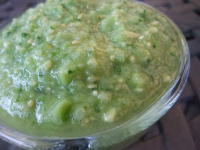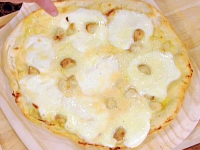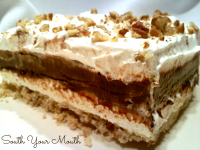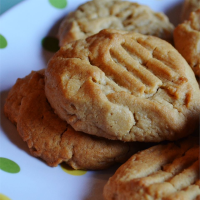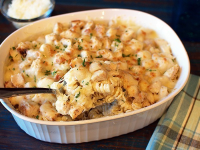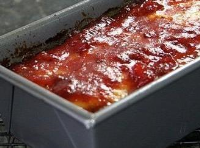CROISSANTS RECIPE | BBC GOOD FOOD

James Martin shares his recipe for this French patisserie classic. It involves some ambitious pastry work, but the end results are worth it
Provided by James Martin
Categories Breakfast
Total Time 1 hours 33 minutes
Prep Time 1 hours 15 minutes
Cook Time 18 minutes
Yield Makes 12-14
Number Of Ingredients 7
Steps:
- Put the flour, salt and sugar in a mixing bowl. Measure 300ml cold water into a jug, add the yeast and stir. Make a well in the flour and pour in the liquid. Mix, then knead on your work surface for 10 mins. Shape into a ball, put in a lightly oiled bowl, cover and chill for at least 2 hrs.
- Put the butter between 2 sheets of baking parchment. Using a rolling pin, bash and roll it into a rectangle about 20 x 15cm. Leave wrapped in the baking parchment and chill.
- Transfer the chilled dough to a floured surface and roll into a 40 x 20cm rectangle. Place the unwrapped slab of butter in the centre of the dough, so that it covers the middle third.
- Fold one side of the dough up and halfway over the butter.
- Fold the other side of the dough up and over the butter in the same way, so that the two edges of the dough meet in the centre of the butter.
- Fold the dough in half so that the point where the ends of the dough meet becomes the seam. Wrap in cling film and chill for 30 mins.
- Repeat the rolling, folding and chilling process (steps 3-6) twice more in exactly the same way – rolling the pastry while it’s still folded – without adding more butter. Wrap and chill overnight.
- The next day, roll the dough out on a floured surface into a large rectangle, measuring about 60 x 30cm. Using a sharp knife or pizza cutter, trim the edges to neaten.
- Cut the dough in half lengthways so that you have 2 long strips, then cut each strip into 6 or 7 triangles with 2 equal sides.
- Take each triangle in turn and pull the two corners at the base to stretch and widen it.
- Starting at the base of each triangle, begin to gently roll into a croissant, being careful not to crush the dough.
- Continue rolling, making sure the tip of each triangle ends up tucked under the croissant to hold in place. If adding any fillings (see tips, below), place across the widest part of the triangle before rolling up.
- Bend the ends of the croissants inwards, then transfer to baking trays lined with baking parchment, spaced well apart. Cover with lightly oiled cling film and leave to rise for 2 hrs, or until doubled in size.
- Heat oven to 200C/180C fan/gas 6. Mix the beaten egg with a pinch of salt and use to generously glaze the croissants. Bake for 15-18 mins until risen and golden brown, then cool on wire racks.
Nutrition Facts : Calories 310 calories, FatContent 19 grams fat, SaturatedFatContent 11 grams saturated fat, CarbohydrateContent 29 grams carbohydrates, SugarContent 4 grams sugar, FiberContent 1 grams fiber, ProteinContent 5 grams protein, SodiumContent 0.9 milligram of sodium
CROISSANTS RECIPE - NYT COOKING

This recipe is a detailed roadmap to making bakery-quality light, flaky croissants in your own kitchen. With a pastry as technical as croissants, some aspects of the process — gauging the butter temperature, learning how much pressure to apply to the dough while rolling — become easier with experience. If you stick to this script, buttery homemade croissants are squarely within your reach. (Make sure your first attempt at croissants is a successful one, with these tips, and Claire Saffitz’s step-by-step video on YouTube.)
Provided by Claire Saffitz
Total Time P1D
Yield 8 croissants
Number Of Ingredients 11
Steps:
- Twenty-four hours before serving, start the détrempe: In the bowl of a stand mixer fitted with the dough hook, combine the flour, sugar, salt and yeast, and stir to combine. Create a well in the center, and pour in the water and milk. Mix on low speed until a tight, smooth dough comes together around the hook, about 5 minutes. Remove the hook and cover the bowl with a damp towel. Set aside for 10 minutes.
- Reattach the dough hook and turn the mixer on medium-low speed. Add the butter pieces all at once and continue to mix, scraping down the bowl and hook once or twice, until the dough has formed a very smooth, stretchy ball that is not the least bit sticky, 8 to 10 minutes.
- Form the dough into a ball and place seam-side down on a lightly floured work surface. Using a sharp knife, cut two deep perpendicular slashes in the dough, forming a “+.” (This will help the dough expand into a square shape as it rises, making it easier to roll out later.) Place the dough slashed-side up inside the same mixing bowl, cover with plastic wrap and let rise at room temperature until about 1 1/2 times its original size, 45 minutes to 1 hour. Transfer the bowl to the refrigerator and chill for at least 4 hours and up to 12.
- As the dough chills, make the butter block: Place the sticks of butter side-by-side in the center of a large sheet of parchment paper, then loosely fold all four sides of the parchment over the butter to form a packet. Turn the packet over and use a rolling pin to lightly beat the cold butter into a flat scant 1/2-inch-thick layer, fusing the sticks and making it pliable. (Don’t worry about the shape at this point.) The parchment may tear. Turn over the packet and unwrap, replacing the parchment with a new sheet if needed. Fold the parchment paper over the butter again, this time making neat, clean folds at right angles (like you’re wrapping a present), forming an 8-inch square. Turn the packet over again and roll the pin across the packet, further flattening the butter into a thin layer that fills the entire packet while forcing out any air pockets. The goal is a level and straight-edged square of butter. Transfer the butter block to the refrigerator.
- Eighteen hours before serving, remove the dough from the refrigerator, uncover and transfer to a clean work surface. (It will have doubled in size.) Deflate the dough with the heel of your hand. Using the four points that formed where you slashed the dough, stretch the dough outward and flatten into a rough square measuring no more than 8 inches on one side.
- Place 2 pieces of plastic wrap on the work surface perpendicular to each other, and place the dough on top. Wrap the dough rectangle, maintaining the squared-off edges, then roll your pin over top as you did for the butter, forcing the dough to fill in the plastic and form an 8-inch square with straight sides and right angles. Freeze for 20 minutes.
- Remove the butter from the refrigerator and the dough from the freezer. Set aside the butter. Unwrap the dough (save the plastic, as you’ll use it again) and place on a lightly floured surface. Roll the dough, dusting with flour if necessary, until 16 inches long, maintaining a width of 8 inches (barely wider than the butter block). With a pastry brush, brush off any flour from the surface of the dough and make sure none sticks to the surface.
- You’re going to enclose the butter block in the dough and roll them out together. To ensure they do so evenly, they should have the same firmness, with the dough being slightly colder than the butter. The butter should be chilled but able to bend without breaking. If it feels stiff or brittle, let sit at room temperature for a few minutes. Unwrap the butter just so the top is exposed, then use the parchment paper to carefully invert the block in the center of the dough rectangle, ensuring all sides are parallel. Press the butter gently into the dough and peel off the parchment paper. You should have a block of butter with overhanging dough on two opposite sides and a thin border of dough along the other two.
- Grasp the overhanging dough on one side and bring it over the butter toward the center, then repeat with the other side of the dough, enclosing the butter. You don’t need the dough to overlap, but you want the two sides to meet, so stretch it if necessary, and pinch the dough together along all seams so no butter peeks out anywhere. Lift the whole block and dust a bit of flour underneath, then rotate the dough 90 degrees, so the center seam is oriented vertically.
- Orient the rolling pin perpendicular to the seam and lightly beat the dough all along the surface to lengthen and flatten. Roll out the dough lengthwise along the seam into a 24-inch-long, 1/4-inch-thick narrow slab, lightly dusting underneath and over top with more flour as needed to prevent sticking. Rather than applying pressure downward, try to push the dough toward and away from you with the pin, which will help maintain even layers of dough and butter. Remember to periodically lift the dough and make sure it’s not sticking to the surface, and try your best to maintain straight, parallel sides. (It’s OK if the shorter sides round a bit — you’re going to trim them.)
- Use a wheel cutter or long, sharp knife to trim the shorter ends, removing excess dough where the butter doesn’t fully extend and squaring off the corners for a very straight-edged, even rectangle of dough. Maintaining the rectangular shape, especially at this stage, will lead to the most consistent and even lamination. If at any point in the process you see air bubbles in the dough while rolling, pierce them with a cake tester or the tip of a paring knife to deflate and proceed.
- Dust any flour off the dough’s surface. Grasp the short side of the rectangle farther from you and fold it toward the midline of the dough slab, aligning the sides. Press gently so the dough adheres to itself. Repeat with the other side of the dough, leaving an 1/8-inch gap where the ends meet in the middle. Now, fold the entire slab in half crosswise along the gap in the center. You should now have a rectangular packet of dough, called a “book,” that’s four layers thick. This is a “double turn,” and it has now quadrupled the number of layers of butter inside the dough.
- Wrap the book tightly in the reserved plastic. If it is thicker than about 1 1/2 inches, or if it’s lost some of its rectangularity, roll over the plastic-wrapped dough to flatten it and reshape it. Freeze the book for 15 minutes, then refrigerate for 1 hour.
- Let the dough sit at room temperature for about 5 minutes. Unwrap and place on a lightly floured surface. Beat the dough and roll out as before (Step 10) into another long, narrow 3/8-inch-thick slab. It should be nice and relaxed, and extend easily. Dust off any excess flour.
- Fold the dough in thirds like a letter, bringing the top third of the slab down and over the center third, then the bottom third up and over. This is a “simple turn,” tripling the layers. Press gently so the layers adhere. Wrap tightly in plastic again and freeze for 15 minutes, then refrigerate for 1 hour.
- Let the dough sit at room temperature for about 5 minutes, then unwrap and place on a lightly floured surface. Beat the dough and roll out as before, but into a 14-by-17-inch slab (15-by-16-inch for pain au chocolat or ham and cheese croissants). The dough will start to spring back, but try to get it as close to those dimensions as possible. Brush off any excess flour, wrap tightly in plastic, and slide onto a baking sheet or cutting board. Freeze for 20 minutes, then chill overnight (8 to 12 hours). If making pain au chocolat or ham and cheese croissants, see recipes.
- Four and a half hours before serving, arrange racks in the upper and lower thirds of the oven. Bring a skillet of water to a simmer over medium-high heat. Transfer the skillet to the floor of the oven and close the door. (The steam released inside the oven will create an ideal proofing environment.)
- As the steam releases in the oven, line two rimmed baking sheets with parchment paper and set aside. Let the dough sit at room temperature for about 5 minutes. Unwrap (save the plastic for proofing), place on a very lightly floured surface, and, if necessary, roll out to 17-by-14 inches. Very thoroughly dust off any excess flour with a pastry brush. Use a wheel cutter or long knife and ruler to cut the shorter sides, trimming any irregular edges where not all the layers of dough fully extend and creating a rectangle that’s exactly 16 inches long, then cut into four 4-by-14-inch rectangles.
- Separate the rectangles, then use the ruler and wheel cutter to slice a straight line from opposite corners of one rectangle to form two long, equal triangles. Repeat with the remaining rectangles to make 8 triangles. Trim the short side of each triangle at a slight angle, making them into triangles with longer sides of equal length.
- Working one triangle at a time, grasp the two corners of the shorter end, the base of the crescent, and tug gently outward to extend the points and widen the base to about 3 inches. Then, gently tug outward from about halfway down the triangle all the way to the point, to both lengthen the triangle and thin the dough as it narrows. Starting at the base (the short end), snugly roll up the dough, keeping the point centered and applying light pressure. Try not to roll tightly or stretch the dough around itself. Place the crescent on one of the parchment-lined baking sheets, resting it on the point of the triangle. If the dough gets too soft while you’re working, cover the triangles and freeze for a few minutes before resuming rolling. Space them evenly on the baking sheets, four per sheet. Very loosely cover the baking sheets with plastic wrap, so the croissants have some room to expand.
- Three and a half hours before serving, open the oven and stick your hand inside: It should be humid but not hot, as the water in the skillet will have cooled. You want the croissants to proof at 70 to 75 degrees. (Any hotter and the butter will start to melt, leading to a denser croissant.) Place the baking sheets inside the oven and let the croissants proof until they’re about doubled in size, extremely puffy, and jiggle delicately when the baking sheet is gently shaken, 2 to 2 1/2 hours. Resist the urge to touch or poke the croissants as they proof: They’re very delicate. Try not to rush this process, either, as an underproofed croissant will not be as light and ethereal.
- Remove the baking sheets from the oven and carefully uncover them, then transfer to the refrigerator and chill for 20 minutes while you heat the oven. Remove the skillet from the oven and heat to 375 degrees.
- In a small bowl, stir the yolk and heavy cream until streak-free. Using a pastry brush, gently brush the smooth surfaces of each crescent with the yolk and cream mixture, doing your best to avoid the cut sides with exposed layers of dough.
- Transfer the sheets to the oven and bake for 20 minutes. Rotate the baking sheets and switch racks, and continue to bake until the croissants are deeply browned, another 10 to 15 minutes. Remove from the oven and let cool completely on the baking sheets.
More about "how to make homemade croissants recipes"
FLAKY BUTTER CROISSANTS RECIPE | LAND O’LAKES
Get the perfect flaky croissant with our butter croissant recipe. Serve these tender flaky pastries for a special brunch.
From landolakes.com
Reviews 4.8
Total Time 1 hours 1 minutes
Category Rolls, Yeast, Butter, Sweet, Savory, Baking, Dairy, Breakfast and Brunch, Bread, Side Dish
Calories 200 calories per serving
From landolakes.com
Reviews 4.8
Total Time 1 hours 1 minutes
Category Rolls, Yeast, Butter, Sweet, Savory, Baking, Dairy, Breakfast and Brunch, Bread, Side Dish
Calories 200 calories per serving
- Beat egg yolk and water in bowl; brush over croissants. Bake 13-16 minutes or until golden brown.
See details
BUTTERY CROISSANTS RECIPE: HOW TO MAKE IT - TASTE OF HOME
A traditional dinner roll like this is always welcome at holiday dinners. This croissant recipe makes a big batch, so it's great when you're entertaining.
From tasteofhome.com
Reviews 5
Total Time 01 hours 15 minutes
Calories 115 calories per serving
From tasteofhome.com
Reviews 5
Total Time 01 hours 15 minutes
Calories 115 calories per serving
- In a small bowl, beat butter and flour until combined; spread into a 12x6-in. rectangle on a piece of waxed paper. Cover with another piece of waxed paper; refrigerate for at least 1 hour., In a large bowl, dissolve yeast in warm water. Add the milk, sugar, egg, salt and 2 cups flour; beat until smooth. Stir in enough remaining flour to form a soft dough. Turn onto a floured surface; knead until smooth and elastic, about 6-8 minutes. , Roll dough into a 14-in. square. Remove top sheet of waxed paper from butter; invert onto half of dough. Remove waxed paper. Fold dough over butter; seal edges. , Roll into a 20x12-in. rectangle. Fold into thirds. Repeat rolling and folding twice. (If butter softens, chill after folding.) Wrap in plastic; refrigerate overnight., Unwrap dough. On a lightly floured surface, roll into a 25x20-in. rectangle. Cut into 5-in. squares. Cut each square diagonally in half, forming two triangles. , Roll up triangles from the wide end; place 2 in. apart with point down on ungreased baking sheets. Curve ends down to form crescent shape. Cover and let rise until doubled, about 45 minutes. , Bake at 375° for 12-14 minutes or until golden brown. Remove to wire racks. Serve warm.
See details
HOMEMADE CHOCOLATE CROISSANTS (PAIN AU CHOCOLATE) RECIPE ...
Here's what you need: flour, water, milk, sugar, salt, instant dry yeast, unsalted butter, cold unsalted butter, egg, sweetened chocolate bar
From tasty.co
Reviews 93
Cuisine French
Calories 687 calories per serving
From tasty.co
Reviews 93
Cuisine French
Calories 687 calories per serving
- Enjoy!
See details
EASY HOMEMADE CROISSANT RECIPE - YOUTUBE
From m.youtube.com
See details
HOMEMADE FRENCH CROISSANTS (STEP BY STEP RECIPE) - THE ...
May 21, 2020 · Egg wash. Brush them on top with an egg wash. Usually an egg wash is 1 egg + egg yolk, but since we’re only making 6 croissants, you can use just 1 yolk + 2 tbsp water/cream/milk. This is mixed until completely smooth, and then very carefully brushed on top of the croissants with a soft pastry brush.
From theflavorbender.com
From theflavorbender.com
See details
HOMEMADE CROISSANTS - JO COOKS
Apr 01, 2019 · Slice the dough into long triangles, and roll each one starting at the wide end until you have a crescent shape. Brush with a lightly beaten egg, and bake on a parchment paper lined sheet for 8-12 minutes at 400F, then turn the oven down to 375 and bake for another 8-12 minutes.
From jocooks.com
From jocooks.com
See details
HOW TO MAKE CROISSANTS | RECIPE - YOUTUBE
From m.youtube.com
See details
BAKER'S CROISSANTS - KING ARTHUR BAKING
Instructions. For the dough: Put the eggs and water in a large mixing bowl. Add 1 tablespoon of the sugar, 3 cups (362g) of the flour, and the yeast. Mix until well blended; set aside to let the sponge work. For the butter: Cut the butter into 1? chunks and combine with the salt and flour at low speed in a stand mixer fitted with the paddle ...
From kingarthurbaking.com
From kingarthurbaking.com
See details
MAKE THIS EASY CROISSANT RECIPE—4 WAYS - THE SPRUCE EATS
Dec 25, 2021 · Combine the salt, sugar, 1 cup flour and yeast. Combine liquid ingredients, butter, and dry ingredients in a mixing bowl on low speed. Beat 2 to 3 minutes on medium speed. Add the egg and beat 1 minute. By hand, stir in enough remaining flour to make a firm dough. Knead on a floured surface 5 to 7 minutes or until smooth and elastic.
From thespruceeats.com
From thespruceeats.com
See details
HOW TO MAKE CLASSIC CROISSANTS - RECIPE - FINECOOKING
Combine all of the dough ingredients in the bowl of a stand mixer fitted with the dough hook. Mix on low speed for 3 minutes, scraping the sides of the mixing bowl once if necessary. Mix on medium speed for 3 minutes. Transfer the dough to a lightly floured 10-inch pie pan or a dinner plate. Lightly flour the top of the dough and wrap well with ...
From finecooking.com
From finecooking.com
See details
HOW TO MAKE FLAKY, FLUFFY CROISSANTS AT HOME | CRAFTSY
Instructions. 1. Mix the Ingredients. In the bowl of a stand mixer or food processor fitted with a dough hook, add milk, water, sugar and yeast. Stir to combine. Add in 2 cups flour and stir to combine. Add in remaining flour and salt and mix until a thick dough forms and starts to pull away from the sides of the bowl.
From craftsy.com
From craftsy.com
See details
HOMEMADE CHOCOLATE CROISSANTS HOW TO MAKE CROISSANTS :EASY ...
From m.youtube.com
See details
THE BEST HOMEMADE CROISSANT RECIPE - ALSO THE CRUMBS PLEASE
Mar 27, 2018 · Ready to make the best homemade Croissant recipe? This is an original French Croissant recipe fully translated into English and calculated in cups and grams. I show you how to make a croissant with a step-by-step video. With secret trick to simulate a professional oven for perfectly flaky French Croissants.
From alsothecrumbsplease.com
From alsothecrumbsplease.com
See details
BASIC HOMEMADE CROISSANT PASTRY DOUGH RECIPE
Jul 19, 2021 · Make the Starter (Détrempe) Gather the ingredients. Mix the yeast into the warm water, stirring until well dissolved. Whisk in the 3/4 cup flour, the warm milk, and the sugar to make a smooth batter. Cover the bowl with plastic and leave the batter to mature in a warm, draft-free place for 1 1/2 to 2 hours.
From thespruceeats.com
From thespruceeats.com
See details
HOW TO MAKE HOMEMADE CROISSANTS / CROISSANT RECIPE - YOUTUBE
#homemade_croissants# Croissant_RecipeHow to make homemade croissants / Croissant Recipe?? ???? ???? ?? ???? ??? ?? ????. ??? ??? ...
From m.youtube.com
From m.youtube.com
See details
DEEP FRIED CROISSANT RECIPE - ALL INFORMATION ABOUT ...
Cronuts: Deep Fried Croissants • My Well Seasoned Life trend www.mywellseasonedlife.com. 1 teaspoon vanilla. 4 tablespoons butter. 3 ½ doughnut cutter. Place yolks, sugar, flour and salt into the bowl of a mixer.
From therecipes.info
From therecipes.info
See details
EASY HOMEMADE CROISSANT RECIPE – MY ROI LIST
Oct 09, 2021 · This simplified croissant recipe will have you baking croissants like a pro. Flaky, buttery, and deliciously authentic, yet so easy to make! Today I am sharing a recipe that has been on my bucket list for years: homemade croissants! I’ve wanted to try making them forever, and there are TONS of croissant recipes out there to choose from.
From myroilist.com
From myroilist.com
See details


















